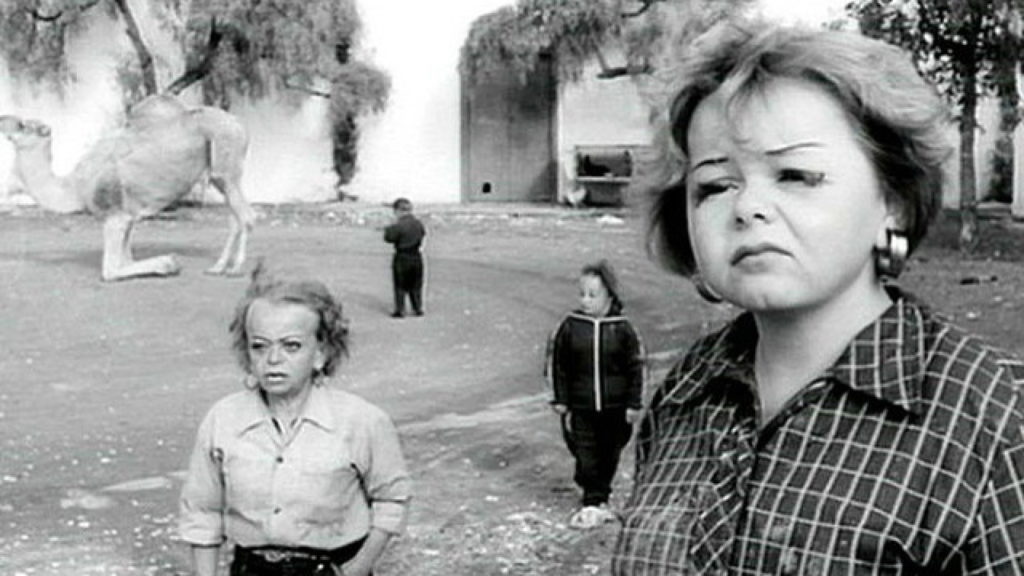From The Unholy Three to The Terror Of Tiny Town and beyond, “little people” have always had a place in the cinema. Perhaps the most unusual of films to predominantly feature “little people” is Werner Herzog’s Even Dwarfs Started Small (1969).
The film is cast entirely of Dwarfs, and set in a world where this is the norm despite the fact that nothing else in this world is scaled down to their size. The narrative concerns the inmates of a prison who have revolted and taken control of the prison compound. They run amok, destroying as they wish.
Having trapped the warden in his office, where he has taken inmate Pepe (Gerd Gickel) hostage, the other inmates redirect their mischief elsewhere. First, they taunt a pair of blind Dwarfs. These blind Dwarfs carry gigantic sticks to aid in their navigating about the compound. The inmates agitate the blind Dwarfs till they wave their gigantic staffs about in a fury, attempting to locate the stone-throwing inmates. This ritual of torture is repeated a number of times. The outcome isn’t very dramatic. The blind Dwarfs clash sticks. Then resolve that their tormentors have departed, which they have. The second encounter results in the slaying of a female pig. In their furious waving about, the blind Dwarfs slaughter a mother pig. Herzog then treats his audience to a number of cut-away shots throughout the remaining duration of the film of the orphaned piglets attempting to suckle their dead mother.
The scenarios described above speak to the ease with which anarchy can motivate the otherwise helpless or passive persons to acts of random violence. Since the film casts the escaped inmates as the protagonists, one must assume that all incidents within the film possess the consideration that they are, in some way, a catalyst. This may seem a rather bizarre mode of narrative structure, but Herzog’s wild inmates function both as protagonists and antagonists, often thwarting their own plans.

A good example of this is the picnic scene. No sooner are all the inmates dining, then a handful of them are decimating the scene with a pick-up truck rigged to drive in perpetual circles. The fun of the picnic is overshadowed by the immense fun the inmates experience putting their meals in the path of the truck. Herzog allows this scene to play out (longer than any other in the film) until the inmates have crucified a monkey in a mockery of Christ’s martyrdom . If one has seen Herzog’s other films one knows of his fascination with destruction.
Yet, the most disturbing images in Even Dwarfs Started Small do not come directly from the inmate Dwarfs, but rather from chickens. From the start of the film, Herzog implements a series of cut-away shots of chickens and roosters pecking at one another. As the film progresses, this pecking has resulted in the loss of limbs, eyes, and general disfigurement amongst the chickens. Without the order of the warden and his lot, no one tends the chickens that, like the inmates, will exercise self-destructive behavior.
Now we have arrived at the crux of the allegory in EvenDwarfs Started Small. The implementing of total control, as Herzog presents it, prompts the controlled or the oppressed to respond in a characteristically destructive manner. However, Herzog is not presenting his audience with any mild form of control one could easily observe first hand, he is presenting a prison in a world of dwarfs. This forces his audience to interpret the events in the film to their political extreme. If one has done this, it seems safe to assume Herzog’s film is a cautionary tale of the results of life under fascism. 1969 may seem a little too late for a German director to address the possible results of fascism, but in West Germany at that time there were a number of conservative and liberal terrorist factions mobilized throughout every major German city. Though American audiences may be ignorant of these issues today, at the time of Even Dwarfs Started Small’s domestic release, this was a poignant commentary.
I would now like to focus our attentions on the opening and closing of the film. The first shot of Even Dwarfs Started Small is of Hombre (Helmut Doring) seated in a chair being questioned by authorities as his mug shot is taken. This scene informs the audience that the rest of the film will be a flashback explaining how Hombre got where he is in the film’s first shot. However, this is not the case. Herzog never takes his audience back to Hombre’s questioning, he’s content to end the film within the flashback, trusting that his audience is intelligent enough to understand the ramifications Hombre faces once recaptured after viewing the rest of the film.
The final shot of Even Dwarfs Started Small is again Hombre. As all the inmates continue to run amok, Hombre has settled down. He stands on the rocky slope of one of the surrounding hills laughing incessantly at a camel that cannot get up no matter how it tries. This shot lasts upwards of ninety seconds. The laughter never stops and the camel never stands. Herzog’s last image leaves us almost in wonder at the futility of life, the effectualness of policy, morale, civility, and decency. But what is Romantic about Herzog is his passion for this futility; his passion for people and characters that stand against it and ultimately fail pathetically.
